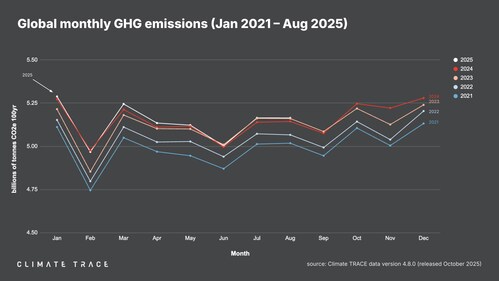Climate TRACE Releases August 2025 Greenhouse Gas Emissions Data
Total global greenhouse gas emissions for the month of August 2025 totaled 5.61 billion tonnes COâ‚‚e. For all updates to Climate TRACE country-, state-, city-, sector-, and asset-level data, visit climatetrace.org.
OAKLAND, Calif., Oct. 30, 2025 /PRNewswire-PRWeb/ -- Today, Climate TRACE reported that global greenhouse gas (GHG) emissions for the month of August 2025 totaled 5.16 billion tonnes COâ‚‚e. This represents an increase of 0.40% vs. August 2024. Total global year-to-date emissions are 41.09 billion tonnes COâ‚‚e. This is 0.30% higher than 2024's year-to-date total. Global methane emissions in August 2025 were 34.85 million tonnes CHâ‚„, a decrease of 1.03% vs. August 2024.
Data tables summarizing GHG emissions totals by sector, country, and top 100 urban areas for August 2025 are available for download .
Greenhouse Gas Emissions by Country: August 2025
Climate TRACE's preliminary estimate of August 2025 emissions in , the world's top emitting country, is 1.50 billion tonnes COâ‚‚e, an increase of 4.89 million tonnes of COâ‚‚e, or 0.33% vs. August 2024.
Of the other top five emitting countries:
- emissions declined by 27.30 million tonnes COâ‚‚e, or 4.54% year over year;
- emissions increased by 0.91 million tonnes COâ‚‚e, or 0.25% year over year;
- emissions increased by 7.63 million tonnes COâ‚‚e, or 3.10% year over year;
- emissions increased by 8.77 million tonnes COâ‚‚e, or 7.02% year over year.
In the EU, which as a bloc would be the fourth largest source of emissions in August 2025, emissions declined by 0.61 million tonnes COâ‚‚e compared to August 2024, or 0.20%.
Greenhouse Gas Emissions by Sector: August 2025
Greenhouse gas emissions increased in August 2025 vs. August 2024 in agriculture, power, transportation, and waste, and decreased in fossil fuel operations. Transportation saw the greatest change in emissions year over year, with emissions increasing by 3.60% as compared to August 2024.
- emissions were 695.58 million tonnes COâ‚‚e, a 0.01% increase vs. August 2024;
- emissions were 249.83 million tonnes COâ‚‚e, unchanged vs. August 2024;
- emissions were 137.71 million tonnes COâ‚‚e, unchanged vs. August 2024;
- emissions were 785.87 million tonnes COâ‚‚e, a 1.88% decrease vs. August 2024;
- emissions were 858.07 million tonnes COâ‚‚e, unchanged vs. August 2024;
- emissions were 21.10 million tonnes COâ‚‚e, unchanged vs. August 2024;
- emissions were 1,409.96 million tonnes COâ‚‚e, a 0.44% increase vs. August 2024;
- emissions were 827.41 million tonnes COâ‚‚e, a 3.60% increase vs. August 2024;
- emissions were 178.86 million tonnes COâ‚‚e, a 0.48% increase vs. August 2024.
Greenhouse Gas Emissions by City: August 2025
The urban areas with the highest total GHG emissions in August 2025 were ;;;; and.
The urban areas with the greatest increases in absolute emissions in August 2025 as compared to August 2024 were ;;;; and. Those with the largest absolute emissions declines between this August and last August were ;;;; and.
The urban areas with the greatest increases in emissions as a percentage of their total emissions were ;;;; and. Those with the greatest decrease by percentage were ;;;; and.
RELEASE NOTES
Revisions to existing Climate TRACE data are common and expected. They allow us to take the most up-to-date and accurate information into account. As new information becomes available, Climate TRACE will update its emissions totals (potentially including historical estimates) to reflect new data inputs, methodologies, and revisions.
With the addition of August 2025 data, the Climate TRACE database is now updated to version V4.8.0. This release updates emissions factors for livestock subsectors to align with the Intergovernmental Panel on Climate Change's 2019 equations and emissions, expands enteric fermentation cattle operations coverage in 29 countries, improves direct and indirect emissions factors for iron and steel to align with the International Energy Agency and the World Steel Association, refreshes aluminum manufacturing data to use more detailed capacity factors instead of aggregated data, updates various aspects of the model for shipping emissions, updates data on oil and gas refineries in China to reflect additional input data, and improves ownership data in the power sector.
A detailed description of data updates is available in our changelog .
To learn more about what is included in our monthly data releases and for frequently asked questions, click . All methodologies for Climate TRACE data estimates are available to view and download . For any further technical questions about data updates, please contact: [email protected].
To sign up for monthly updates from Climate TRACE, click .
Emissions data for September 2025 are scheduled for release on November 27, 2025.
About Climate TRACE
The Climate TRACE coalition was formed by a group of AI specialists, data scientists, researchers, and nongovernmental organizations. Current members include Carbon Yield; Carnegie Mellon University's CREATE Lab; CTrees; Duke University's Nicholas Institute for Energy, Environment & Sustainability; Earth Genome; Former Vice President Al Gore; Global Energy Monitor; Global Fishing Watch/emLab; Johns Hopkins University Applied Physics Lab; OceanMind; RMI; TransitionZero; and WattTime. Climate TRACE is also supported by more than 100 other contributing organizations and researchers, including key data and analysis contributors: Arboretica, Michigan State University, Ode Partners, Open Supply Hub, Saint Louis University's Remote Sensing Lab, and University of Malaysia Terengganu. For more information about the coalition and a list of contributors, click .
Media Contact
Fae Jencks and Nikki Arnone, Climate TRACE, 1 (719) 357-8344, [email protected],
SOURCE Climate TRACE



Share this article